-
Duck Cold! Four French phrases to use when it is freezing outside
We remind you of French expressions to use to describe the drop in temperature
-
When and why do we say le moral dans les chaussettes?
We explore this useful expression that describes low spirits
-
The origins and meaning of tirer les marrons du feu
As Christmas approaches, we look at a phrase to describe someone who takes advantage of a situation
Local authorities act as toxic caterpillars appear again in France
Authorities are gearing up to fight the insects as warmer weather begins. The caterpillars’ hairs can be harmful to humans and pets and they damage trees

Processionary caterpillars, which damage trees and whose hairs can cause skin and respiratory irritation, are back in France as spring approaches, prompting authorities to take action.
The caterpillar season is starting across the country, especially in the southern departments where temperatures are warmer (although the caterpillars are found nationwide).
As well as posing an irritant risk to humans and domestic animals, the toxic chenilles processionnaires (as they are known in French) also damage trees. They can cause pine trees especially to lose all of their needles, making them more vulnerable to parasite attacks and diseases.
The risk has led authorities in badly-affected areas to take action, especially as experts are predicting a rise in the caterpillar population in 2022 but equally next year [in 2023].
Forest health department le Département de la santé des forêts in Aveyron, Occitanie told Actu.fr: “At this stage, specialists are predicting a peak next year.”
The department uses a type of natural, bacterial insecticide to fight against the caterpillars, called BTK (Bacillus thuringiensis), which is toxic to insects and caterpillars but not humans. It must be used in autumn for maximum effect.
Authorities have also installed predator boxes and eco-friendly traps especially designed for the chenilles.
One town even went further; in 2018, the mairie of Millau (Aveyron, Occitanie) took out a decree stating that people who did not take steps to help eradicate the caterpillars would risk a fine. Residents who did not take part in the local anti-chenille measures were first sent a letter recommending ways to destroy the nests or trap the caterpillars. Further inaction would then lead to a €38 fine.
Residents also joined together to make group purchases of traps in particularly badly-affected areas.
Where are the caterpillars found?
They proliferate in warmer areas, but global warming has caused them to spread further and further north. They are now found nationwide, including in Ile-de-France, Brittany, and Grand Est, as well as in southern regions such as Occitanie.
What are they?
They are caterpillars that hatch from nests in trees, and will eventually become moths. They can measure 40mm (4cm) long. They are covered in tiny hairs that can be irritating and cause allergies for humans and pets. If eaten by dogs or cats, they can even be poisonous.
They are recognisable by their “furry” appearance, and by their tendency to create long “lines” on trees or on the ground, hence the name “chenilles processionnaires” (processionary, or in rows).
There are two kinds: The oak processionary caterpillar, which comes out from spring to summer; and the pine processionary, which is more active from autumn to spring.
The oak caterpillar tends to stay in the trees, while the pine is more likely to be seen on the ground.
Read more:Two types of processionary caterpillars gaining ground in France
How do they present a risk?
Their tiny hairs are thrown into the air when the caterpillars sense a threat. These give off a toxic irritant that can cause skin and respiratory irritation. The insects can also sting if they feel very threatened.
They can also cause severe eye problems if they come into contact with the eyes and are not removed quickly, and people who have allergies risk an anaphylactic shock if they are accidentally stung.
However, a June 2020 report from health authority Anses found that 96.3% of exposure to the hairs caused mild issues, and only 0.2% provoked severe problems.
They can also present similar problems for animals. Cats and dogs, and even horses or cows, risk problems if they bite or lick a caterpillar, or if they are stung, especially in their mouth.
What if someone or a pet is stung?
Wash the area abundantly with water, without rubbing the area (to avoid breaking the small hairs into even smaller pieces). Use sticky tape to try to pull up the hairs from the affected area. You may need to use antihistamine cream or take antihistamines to calm any irritation or inflammation.
People with severe reactions or allergies should contact a doctor, and anyone with concerns for their pet should contact a vet.
How can I avoid them?
You can contact your local mairie to see if they have any measures in place to fight against the caterpillars, such as traps or boxes, or insecticide-spraying plans.
You can also buy your own traps, and install bird feeders and bird huts to encourage birds to settle, as they can often eat the caterpillars as food.
A statement from regional health agency l’Agence Régionale de Santé Grand Est recommended:
- When out in nature or forests, be aware of any caterpillars and avoid touching them
- Wear covered clothing when walking outside
- Avoid drying clothes near trees
- Wash your fruit and vegetables before eating them
Related articles
Toxic processionary caterpillars in France already
Early sightings of poisonous caterpillars reported in France
























